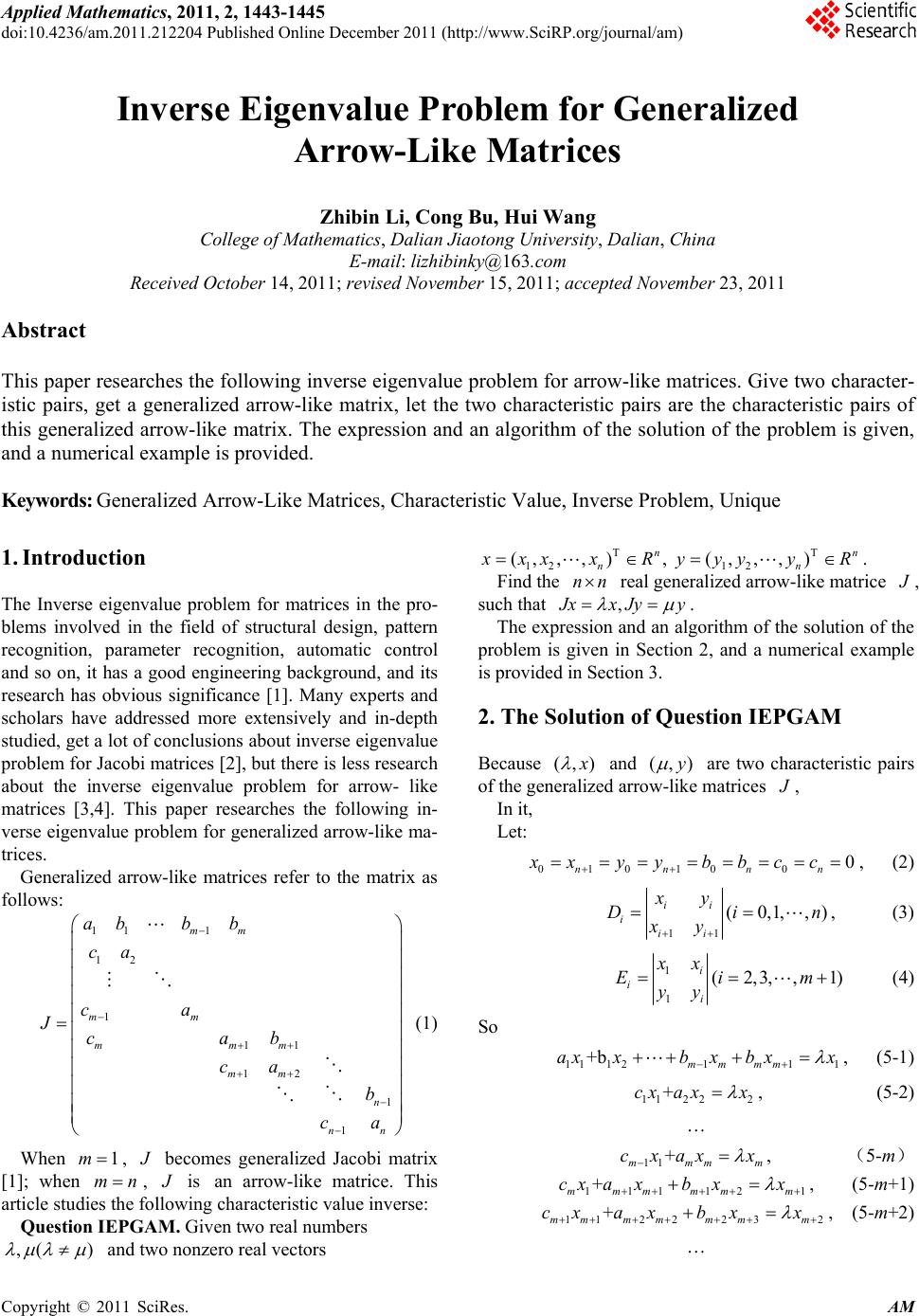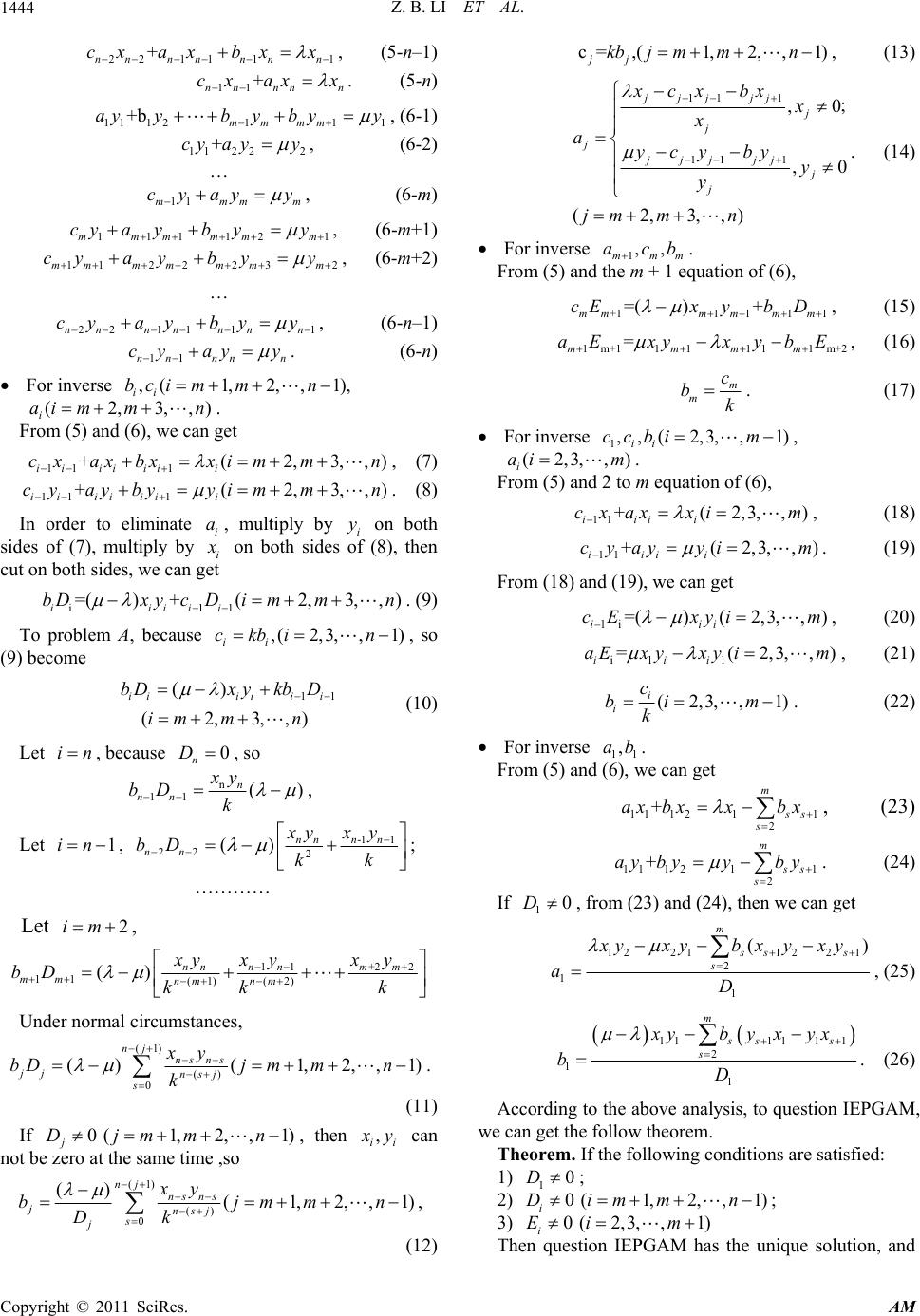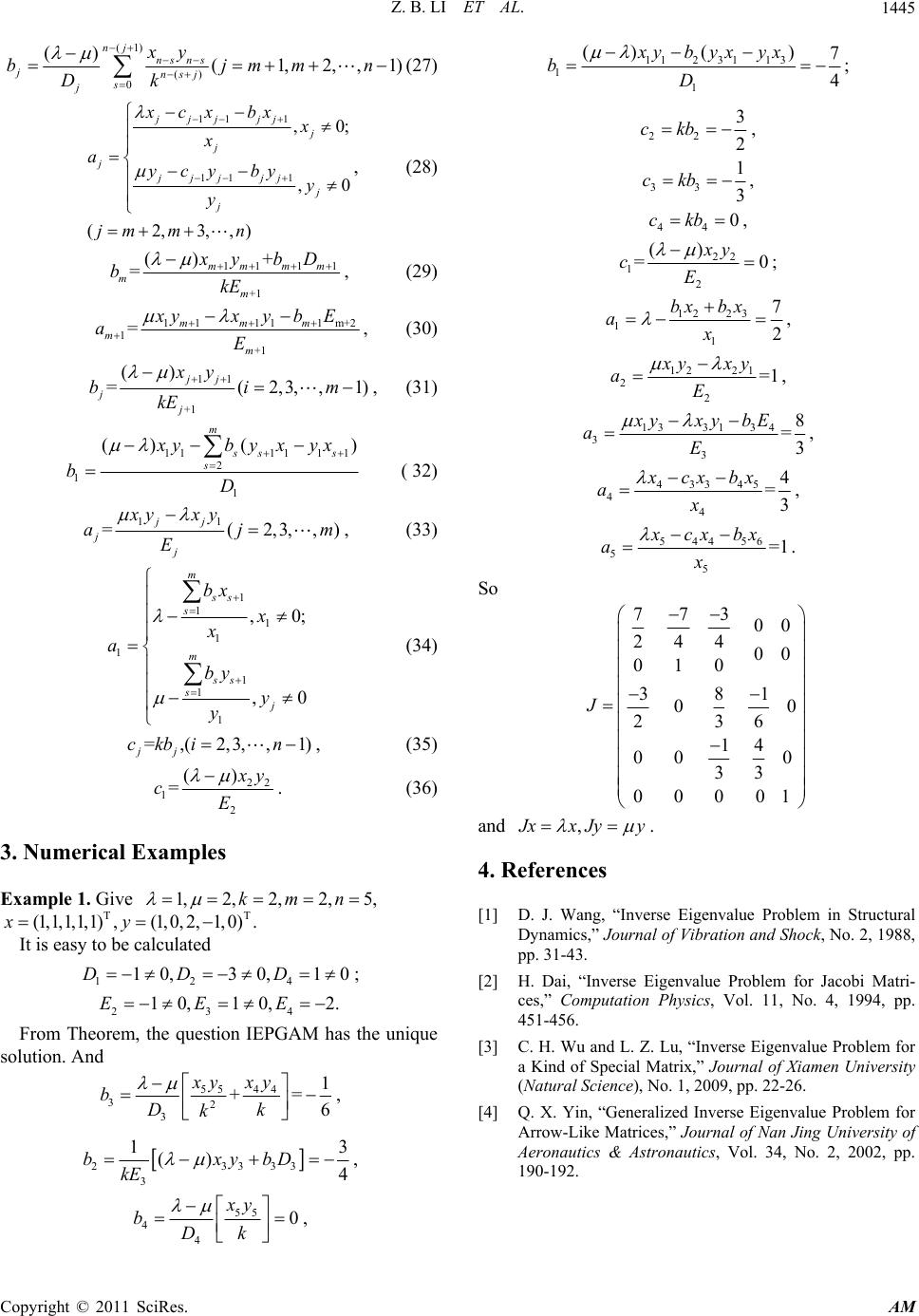Paper Menu >>
Journal Menu >>
 Applied Mathematics, 2011, 2, 1443-1445 doi:10.4236/am.2011.212204 Published Online December 2011 (http://www.SciRP.org/journal/am) Copyright © 2011 SciRes. AM Inverse Eigenvalue Problem for Gen eralized Arrow-Like Matrices Zhibin Li, Cong Bu, Hui Wang College of Mathematics, Dalian Jiaotong University, Dalian, China E-mail: lizhibinky@163.com Received October 14, 2011; revised November 15, 2011; accepted November 23, 2011 Abstract This paper researches the following inverse eigenvalue problem for arrow-like matrices. Give two character- istic pairs, get a generalized arrow-like matrix, let the two characteristic pairs are the characteristic pairs of this generalized arrow-like matrix. The expression and an algorithm of the solution of the problem is given, and a numerical example is provided. Keywords: Generalized Arrow-Like Matrices, Characteristic Value, Inverse Problem, Unique 1. Introduction The Inverse eigenvalue problem for matrices in the pro- blems involved in the field of structural design, pattern recognition, parameter recognition, automatic control and so on, it has a good engineering background, and its research has obvious significance [1]. Many experts and scholars have addressed more extensively and in-depth studied, get a lot of conclusions about inverse eigenvalue problem for Jacobi matrices [2], but there is less research about the inverse eigenvalue problem for arrow- like matrices [3,4]. This paper researches the following in- verse eigenvalue problem for generalized arrow-like ma- trices. Generalized arrow-like matrices refer to the matrix as follows: 11 1 12 1 11 12 1 1 mm mm mmm mm n nn abb b ca ca Jcab ca b ca (1) When , 1m J becomes generalized Jacobi matrix [1]; when , mn J is an arrow-like matrice. This article studies the following characteristic value inverse: Question IEPGAM. Given two real numbers ,( ) and two nonzero real vectors T 12 (, ,, ), n n x xx xRT 12 (, , ,)n n y yy yR. Find the nn real generalized arrow-like matrice J , ch that su, J xxJyy (,) . The expression and an algorithm of the solution of th e problem is given in Section 2, and a numerical example is provided in Section 3. 2. The Solution of Question IEPGAM Because x and (,)y are two characteristic pairs of the generalized arrow-like matrices J , In it, Let: 010nn xx yy 100 0 nn bbcc , (2) 11 (0,1,,) ii iii xy Di xy n, (3) 1 1 (2,3,, 1 i ii xx Eim yy ) (4) So 11 12111 +b mm mm axxbxb xx , (5-1) 112 22 +cx axx , (5-2) … 11 + mmm cxax x m 111 12mmm mm axb x , (5-m) 1 +m cx x 2 22 3m mm m ax bx , (5-m+1) 11 + mm cx x 2m , (5-m+2) …  Z. B. LI ET AL. 1444 122 111 + n nnnnnn cx axbxx 11 + nn nn cx ax , (5-n–1) n x . (5-n) 11 12111 +b mm mm ayybyb yy 112 22 +cy ayy , (6-1) , (6-2) … 11mmm cyay y m , (6-m) 11112mmmmm m cyaybyy1 112 22 3mmm mm mm cy aybyy , (6-m+1) 2 , (6-m+2) … 2211 1nnnn nnn cyay byy 1 11nn nnn cy ayy , (6-n–1) . (6-n) For inverse . ,(1,2,,1), ii bci mmn ,3,,)m n(2ai m i From (5) and (6), we can get 11 1 +(2, iiii iii cxaxbxxi mmn3,,) 11 1 +(2, iiiiiii cyay byyimmn , (7) 3,,) . (8) In order to eliminate , multiply by i on both sides of (7), multiply by i i a y x on both sides of (8), then cut on both sides, we can get i11 =()+(2,3,, ) iiiii bDxyc Dimmn . (9) To problem A, because ,(2,3, ,1) ii ckbin , so (9) become 1 () (2,3,,) iiiii i bDxykb D im mn 1 (10) Let , because , so in0 n D n 11 () n nn xy bD k 1in , Let , -1 1 22 2 () nnnn nn xyx y bD k k ; ………… Let , 2im 11+2 2 11 (1) (2) () nnn nmm mm nmnm xyx yxy bD k kk Under normal circums ta n ce s, (1) () 0 ()( 1,2,, nj ns ns jj nsj s xy bDj mmn k 1). (11) If , then 0 (1,2,,1) j Djmm n , ii x y can not be zero at the same time ,so (1) () 0 () (1,2,, nj ns ns jnsj s j xy bjmm Dk 1) n , (12) c=,(1,2, ,1) jj kbj mmn , (13) 11 1 11 1 ,0 ,0 (2,3,,) jjjjj j j jjjjjj j j xcxbx x x aycybyy y jm mn ; . (14) For inverse ,,. 1mmm From (5) and the m + 1 equation o f (6), acb +11 111 =( )+ mmm mmm cExyb D , (15) 1m+111111m+2 = mmmm aE xyxybE , (16) m m c bk . (17) For inverse 1,,(2,3, ,1) ii ccbi m ,,)m, (2,3ai i . From (5) and 2 to m equation of (6), 11 +(2,3, iiii cxax xim,) , (18) 11 +(2,3, iiii cyay yim,) . (19) From (18) and (19), we can get 1i =()(2,3,,) iii cE xyim , (20) i11 =(2,3, iii aExyxy im,) , (21) (2,3,, 1) i i c bi m k . (22) For inverse ,ab. 11 From (5) and (6), we can get 11 1211 2 +m s s s ax bxxbx , (23) 11 1211 2 +m s s s ay byyby . (24) If 10D , from (23) and (24), then we can get 1221122 1 2 11 () m ss s s xyxyb xyxy aD , (25) 11111 1 2 11 m sss s xyb yxyx bD . (26) According to the above analysis, to question IEPGAM, we can get the follow theorem. Theorem. If the following conditions are satisfied: 1) 10D ; 2) 0 (Di1,2, ,1) imm n 0 (2, 3,,1)Ei m; 3) i Then question IEPGAM has the unique solution, and Copyright © 2011 SciRes. AM  Z. B. LI ET AL. Copyright © 2011 SciRes. AM 1445 (1) () 0 () (1,2,, nj nsns jnsj s j xy bjmm Dk 1) n (27) 112 3113 11 () () 7 4 xyb yxyx bD ; 11 1 111 ,0 ,0 (2,3,,) jjjjjj j jjjjjjj j xcxbx x x aycyby y y jm mn 22 3 2 ckb , ; , (28) 33 1 3 ckb , 44 0ckb , 22 12 () =0 xy cE ; 111 1 +1 ()+ =mmm m mm xy bD bkE , (29) 12 23 11 7 2 bx bx ax , 1111 1m+2 1+1 =mm m mm xyxyb E aE , (30) 12 21 22 =1 xy xy aE , 11 +1 () =(2,3, jj jj xy bi kE ,1)m , (31) 13313 4 33 8 =3 xyxy bE aE , 111111 2 11 () ( m sss s xyb yxyx bD ) ( 32) 43345 44 4 =3 xcxbx ax , 11 =(2,3, jj jj xy xy aj E ,)m , (33) 54456 55 =1 xcxbx ax . 1 11 1 1 1 1 1 ,0 ,0 m ss s m ss sj bx x x a by y y So 773 00 24400 010 381 00 236 14 00 0 33 000 01 J ; ) (34) =,(2,3,,1 jj ckbin, (35) 22 12 () = x y cE . (36) and , J xxJyy . 3. Numerical Examples 4. References Example 1. Give 1,2, 2,2, 5,kmn TT (1,0,2,1,0) . [1] D. J. Wang, “Inverse Eigenvalue Problem in Structural Dynamics,” Journal of Vibration and Shock, No. 2, 1988, pp. 31-43. (1,1,1,1,1) ,xy It is easy to be calculated 124 10,30, 10DDD ; [2] H. Dai, “Inverse Eigenvalue Problem for Jacobi Matri- ces,” Computation Physics, Vol. 11, No. 4, 1994, pp. 451-456. 234 10, 10,2.EEE From Theorem, the question IEPGAM has the unique solution. And 55 44 32 3 1 += 6 xy xy bDk k , [3] C. H. Wu and L. Z. Lu, “Inverse Eigenvalue Problem for a Kind of Special Matrix,” Journal of Xiamen University (Natural Science), No. 1, 2009, pp. 22-26. 23333 3 1 () 4 bxybD kE 3 , [4] Q. X. Yin, “Generalized Inverse Eigenvalue Problem for Arrow-Like Matrices,” Journal of Nan Jing University of Aeronautics & Astronautics, Vol. 34, No. 2, 2002, pp. 190-192. 55 44 0 xy bDk , |

